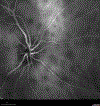Classification Criteria for Birdshot Chorioretinitis
- PMID: 33845003
- PMCID: PMC8517033
- DOI: 10.1016/j.ajo.2021.03.059
Classification Criteria for Birdshot Chorioretinitis
Abstract
Purpose: To determine classification criteria for birdshot chorioretinitis.
Design: Machine learning of cases with birdshot chorioretinitis and 8 other posterior uveitides.
Methods: Cases of posterior uveitides were collected in an informatics-designed preliminary database, and a final database was constructed of cases achieving supermajority agreement on diagnosis, using formal consensus techniques. Cases were split into a training set and a validation set. Machine learning using multinomial logistic regression was used on the training set to determine a parsimonious set of criteria that minimized the misclassification rate among the infectious posterior uveitides / panuveitides. The resulting criteria were evaluated on the validation set.
Results: One thousand sixty-eight cases of posterior uveitides, including 207 cases of birdshot chorioretinitis, were evaluated by machine learning. Key criteria for birdshot chorioretinitis included a multifocal choroiditis with (1) the characteristic appearance of a bilateral multifocal choroiditis with cream-colored or yellow-orange, oval or round choroidal spots ("birdshot" spots); (2) absent to mild anterior chamber inflammation; and (3) absent to moderate vitreous inflammation; or multifocal choroiditis with positive HLA-A29 testing and either classic "birdshot spots" or characteristic imaging on indocyanine green angiography. Overall accuracy for posterior uveitides was 93.9% in the training set and 98.0% (95% confidence interval 94.3, 99.3) in the validation set. The misclassification rates for birdshot chorioretinitis were 10% in the training set and 0% in the validation set.
Conclusions: The criteria for birdshot chorioretinitis had a low misclassification rate and seemed to perform sufficiently well for use in clinical and translational research.
Copyright © 2021 Elsevier Inc. All rights reserved.
Conflict of interest statement
Figures
References
-
- Ryan SJ, Maumenee AE. Birdshot retinochoroidopathy. Am J Ophthalmol 1980; 89:31–45. - PubMed
-
- Gass JD. Vitiliginous chorioretinitis. Arch Ophthalmol 1981;99:1778–87. - PubMed
-
- Monnet D, Brezin AP, Holland GN, Yu F, Mahr A, Gordon LK, Levinson RD. Longitudinal cohort study of patients with birdshot chorioretinopathy. I. Baseline clinical characteristics. Am J Ophthalomol 2006;141:135–42. - PubMed
-
- Monnet D, Levinson RD, Holland GN, Haddad L, Yu F, Brezin AP. Longitudinal cohort study of patients with birdshot chorioretinopathy. III. Macular imaging at baseline. Am J Ophthalmol 2007;144:818–28. - PubMed
Publication types
MeSH terms
Grants and funding
LinkOut - more resources
Full Text Sources
Other Literature Sources
Research Materials



